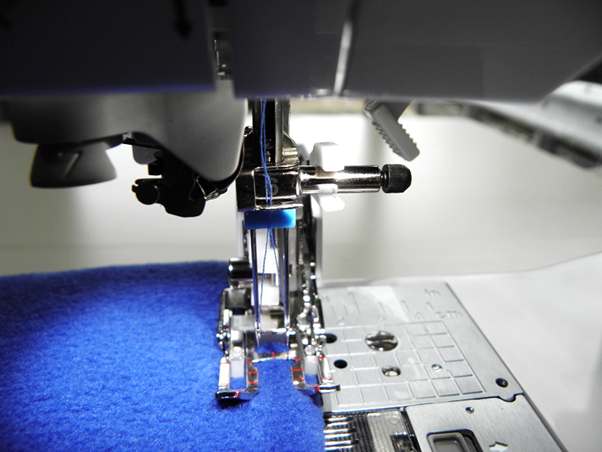Winter is on the way - Sewing fleece can be a lot of fun, so now's a great time to give it a go!
 Fleece is a non-woven fabric made from 100% polyester and is mainly suitable for outdoor clothing and other garments. Warm and soft to the touch, fleece is a good insulator and is also very easy to care for. It’s machine washable and will not wrinkle. Most sewing machines will cope quite easily with fleece.
Fleece is a non-woven fabric made from 100% polyester and is mainly suitable for outdoor clothing and other garments. Warm and soft to the touch, fleece is a good insulator and is also very easy to care for. It’s machine washable and will not wrinkle. Most sewing machines will cope quite easily with fleece.
Some machines may stall when bulk is encountered; particularly when sewing over folded seams on hems and cuffs, etc. This is because the presser foot will tilt upwards at a very acute angle, causing the fabric to jam between the needle plate and the sole of the presser foot. Reducing the machine's foot pressure will allow the presser foot to ride over the bulky seam.
Always use a good quality, general purpose thread such as Gutermann Sew-All and a universal / standard point needle, size: 90/14.
Also, there are devices that can be implemented to level the presser foot making it really easy to sew across the bulk.
Here we see our presser foot levelling plate (also called button plate) which is really easy to use:

Stop machining when the bulk of the seam meets the presser foot. You then lift the foot and slide the plate to the rear. Now lower the foot and continue to sew across the bulk. The plate is then removed when you've sewn over the seam. This is also ideal for thick seams on jeans, etc.
Fleece does not fray too easily, so neatening seams is not essential, but you can neaten with a regular or three step zigzag stitch, if required.
However, you may find because of the stretchy nature of fleece, that the fabric edge will curl and wave.

Yuck! you don't want this happening when you're neatening fleece.
The problem is caused because the fleece stretches as it's fed through the machine.

The best way of preventing stretch is to use a walking foot (also known as even feed or dual feed) Here, you can see that the fabric edge is being guided along the right toe of the foot and neatened with a zigzag stitch (width 5 and length 2)

In this example, you can see the difference that a walking foot will make - no wavey edge.
For a commercially made appearance on hems, use a 4mm twin needle, or better still, a 6mm twin needle (providing your machine has a 7mm stitch width) set the machine for straight stitch ( with the length set to 4 or 5) Ideally, use the walking foot as this will prevent the hem from waving.
Here we see the machine setup with a twin needle. It's essential to make sure you have the settings at straight stitch with the needle on centre position, otherwise you'll break the needle.

The hem has been sewn with two parallel lines of stitching for a more professional appearance. On the inside, the excess fabric has been trimmed back to the edge of the stitching.
Use your machine’s overcast (overlock) stitch to attach cuffs, neckbands, collars, etc.

Most basic to mid range machines will feature stitches like those shown here.

In this example, the strip of fleece is folded and then sewn to the edge of the garment neck with the overcast stitch. The walking foot will prevent stretch, particularly when sewing round a curved shape. Use the right toe of the foot to guide the fabric. All three layers of the fabric are sewn together and neatened simultaneously.

Neckline shown here achieved using the overcast stitch and walking foot

The cuff on this sleeve is attached using the same method.
Using an overlocker is by far the best method for garment construction when working with any stretchy fabric.
If you do a lot of this type of sewing, then the many benefits of using an overlocker will far out-way the initial investment cost. You only need to spend around £200 -£250 for a basic one with a special feed system (differential feed) that eliminates waving on seams and raw edges. In addition, several process are carried out in one go: fabric pieces are sewn together, neatly trimmed and overlocked in one process – a great time saver.

This picture shows the excess fabric being trimmed whilst the two fabric layers are sewn together and neatened 
The result is a professional finish with the seam lying perfectly flat. In this example, flock thread has been used on the loopers, combined with Gutermann Sew All thread on the needles. This combination will prevent the seam stitches from breaking should the garment get stretched.

Here we see three layers sewn together and neatened; this technique can be used for inserting a cuff at the bottom of a sleeve or finishing round a neckband or armhole.
